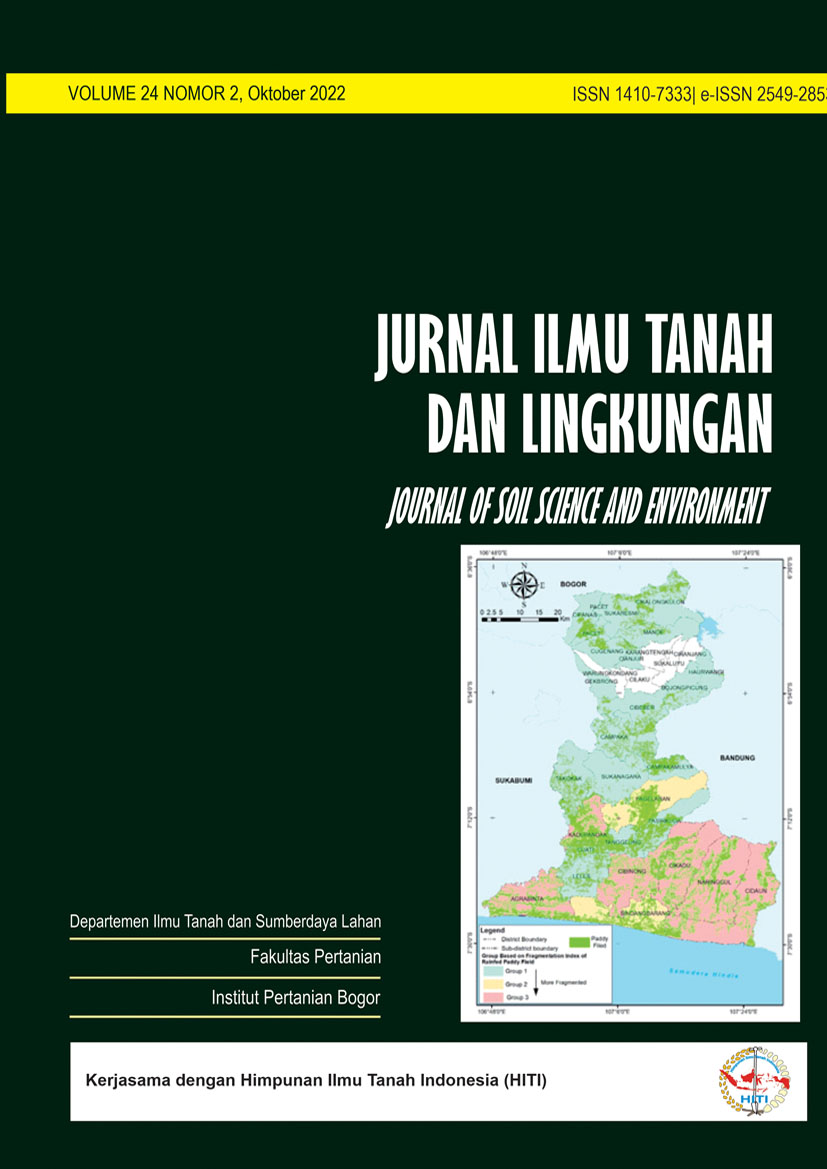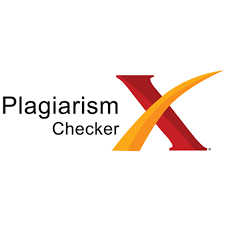Estimating Chlorophyll and N Content in Corn Leaves Based on Chlorophyll Content Index
Estimasi Kadar Klorofil Dan Kadar N Daun Jagung Menggunakan Chlorophyll Content Index
Abstract
The chlorophyll content is related to the condition of the plant so that it can be used to estimate nutrient content in plants. The conventional measurement of leaf chlorophyll content is time consuming and expensive, so a fast and efficient technology is needed. This study aims to (a) analyze the chlorophyll content index (CCI) and leaf chlorophyll content in 10 fertilizer dosage treatments including control and several growth phases of corn, (b) analyze the relationship between CCI and leaf chlorophyll content, and (c) analyze the relationship between CCI and N content. In this study, the CCI was measured with a chlorophyll meter, while the chlorophyll content and N content of leaves were measured using a spectrophotometer and the Kjehdahl method, respectively. The relationship between CCI on chlorophyll content and N content was analyzed at 4 and 8 weeks after planting (WAP) using a simple linear regression model. The results showed that the CCI curve pattern in all dosage treatments was similar as indicated by the CCI increasing with increasing plant age and then decreasing with plant aging. Fertilizer dose had a significant effect on CCI except at 2 and 3 WAP, where the highest CCI was found at fertilizer doses with high nutrient adequacy, i.e. 2 Ultra Gen (UG) + 2/3 Standard (STD) at 7 MST. The CCI and chlorophyll content had a positive linear relationship at 4 WAP and 8 WAP with a strong (r = 0.67) and very strong (r = 0.76) correlation. The relationship model between CCI and leaf N content showed a very strong positive correlation at 8 WAP with the equation N (%) = 0.019*CCI + 1.795 (r = 0.75). These results indicate that the measurement of the CCI with a chlorophyll meter can be used to estimate the N nutrient status of plant leaves properly.
Downloads
References
Efendi R, Suwardi, Syafruddin, Zubachtirodin. 2012. Penentuan takaran pupuk nitrogen pada tanaman jagung hibrida berdasarkan klorofil meter dan bagan warna daun. Jurnal Penelitian Pertanian Tanaman Pangan, 31(1): 27–34.
Ghasemi M, Ghasemi K, Yadollahi A, Ghasemi S, Khorrami SS. 2011. Estimate of leaf chlorophyll and nitrogen content in Asian Pear (Pyrus serotina Rehd.) by CCM-200. Notulae Scientia Biologicae, 3(1): 91–94.
Hidayah F, Santosa S, Putri RE. 2019. Model prediksi hasil panen berdasarkan pengukuran non-destruktif nilai klorofil tanaman padi. Agritech., 39(4): 289-297.
[KEMENTAN] Kementrian Pertanian Republik Indonesia. 2021. Inilah 10 Provinsi Produsen Jagung Terbesar Indonesia. https://www.pertanian.go.id/home/?show=news&act=view&id=4639#:~:text=Berdasarkan%20laporan%20prognosa%20penghitungan%20Pusat,mencapai%205%2C16%20juta%20ha.
Lattanzi FA, Schnyder B, Thornton. 2005. The sources of carbon and nitrogen supplying leaf growth. Assessment of the role of stores with compartmental models. Plant Physiology, 137: 383–395.
Lotfiomran N, Köhl M, Fromm J. 2016. Interaction Effect between Elevated CO2 and Fertilization on Biomass, Gas Exchange and C/N Ratio of European Beech (Fagus sylvatica L.). Plants, 5(3) 38: 1-13.
Nugroho B.A. 2005. Strategi Jitu Memilih Metode Statistik Penelitian dengan SPSS. Yogyakarta: Andi.
Padilla F.M., *, de Souza R., M. Peña-Fleitas M.T., Gallardo M., Giménez C., Thompson R.B. 2018. Different Responses of Various Chlorophyll Meters to Increasing Nitrogen Supply in Sweet Pepper. Front. Plant Sci., 9:1752
Parry C, Blonquist J M, Bugbee B. 2014. In situ measurement of leaf chlorophyll concentration:analysis of the optical/absolute relationship. Plant Cell and Environment, 37:2508–2520.
Purwanto S. 2008. Perkembangan Produksi dan Kebijakan dalam Peningkatan Produksi Jagung. Direktorat Budi Daya Serealia. Bogor (ID): Direktorat Jenderal Tanaman Pangan
Putri RE, Yahya A, Adam N M, Aziz SA. 2016. Variability of rice yield with respect to crop health. Jurnal Teknologi, 78(1–2):79–85.
Richmond A. 2004. Handbook of Microalgal Culture: Biotechnology and Applied Phycology. Blackwell Science Ltd. Oxford. 566 p.
Syafruddin. 2015. Manajemen pemupukan nitrogen pada tanaman jagung. Jurnal Litbang Pertanian. 34(3):105–116.
Setiawati T, Saragih IE, Nurzaman M, Mutaqin AZ. 2016. Analisis Kadar Klorofil dan Luas Daun Lampeni (Ardisia humilis Thunberg) pada Tingkat Perkembangan yang Berbeda di Cagar Alam Pangandaran., Jatinangor: 27–28 Oktober 2016. Hal. 122–126.
Solikhah R, Purwantoyo E, Rudyatmi E. 2019. Aktivitas antioksidan dan kadar klorofil kultivar singkong di daerah Wonosobo. Life ScienceI, 8(1): 86–95.
Suyatman. 2020. Menyelidiki energi pada fotosintesis tumbuhan. Jurnal Pendidikan IPA, 9(2): 125-131.
Syukur M, Rifianto A. 2013. Jagung Manis. Jakarta(ID): Penebar Swadaya.
Wibisono A, Basri M. 1993. Pemanfaatan Limbah Organik untuk Kompos. Jakarta (ID): Penebar Swadaya
Copyright (c) 2022 Jurnal Ilmu Tanah dan Lingkungan

This work is licensed under a Creative Commons Attribution-ShareAlike 4.0 International License.
Department of Soil Science and Land Resources Departemen Ilmu Tanah dan Sumberdaya Lahan, Faculty of Agriculture Fakultas Pertanian, IPB University



















